Free website hosting offers a tempting entry point for online projects, but it’s crucial to understand the limitations.
While services like GitHub Pages, Netlify, InfinityFree, Google Firebase Hosting, Vercel, Cloudflare Pages, and Heroku offer free tiers, they often come with restrictions on storage, bandwidth, features, and performance.
These limitations can significantly impact your website’s functionality and user experience.
Choosing the right platform depends on your project’s specific needs and expected growth.
| Provider | Suitable For | Unsuitable For | Key Limitations | Link |
|---|---|---|---|---|
| GitHub Pages | Static websites, portfolios, documentation | Dynamic websites, high traffic, complex applications | Limited customization, static content only | https://pages.github.com/ |
| Netlify | Static websites, fast-loading sites, JAMstack apps | Large, complex websites, high traffic | Resource limits, potential scaling issues | https://www.netlify.com/ |
| InfinityFree | Basic websites, small projects | High-traffic websites, demanding apps | Ads, performance limitations, resource limits subject to fair use policies | https://infinityfree.net/ |
| Google Firebase Hosting | Simple web apps, static sites | Resource-intensive apps, high traffic | Free tier limits, potential scaling challenges | https://firebase.google.com/docs/hosting |
| Vercel | Next.js projects, modern JavaScript frameworks | Large, complex websites, high traffic | Resource limits, potential scaling issues | https://vercel.com/ |
| Cloudflare Pages | Static websites, fast-loading sites, security-focused | Large, complex websites, high traffic | Resource limits, potential scaling issues, relatively newer platform | https://pages.cloudflare.com/ |
| Heroku | Server-side applications, dynamic websites | Static websites, high traffic, resource-intensive apps | Downtime if idle, memory, storage, and processing power limitations | https://www.heroku.com/ |
Remember to carefully review each provider’s terms of service before making a decision.
|
0.0 out of 5 stars (based on 0 reviews)
There are no reviews yet. Be the first one to write one. |
Amazon.com:
Check Amazon for Free Host Website Latest Discussions & Reviews: |
While free hosting can be a great starting point, be prepared to upgrade to a paid plan as your project grows and its needs evolve.
Read more about Free Host Website
Decrypting the Allure of Free Website Hosting: What’s the Real Deal?

This whole “free website hosting” thing sounds too good to be true, right? And you’d be mostly right. There’s a reason these services are free – it’s not pure altruism. But that doesn’t mean they’re useless. Let’s cut through the marketing hype and figure out what’s actually on offer and whether it’s a good fit for your needs. We’ll look at several popular options, highlighting their strengths, weaknesses, and the often-unmentioned fine print. Remember, free often means limitations, so we’ll be realistic about what you can expect.
The Initial Hook: Why Free Hosting Tempts So Many
The lure of free website hosting is powerful, especially for beginners.
Who wouldn’t want to launch a website without any upfront costs? It lowers the barrier to entry dramatically, allowing anyone with an idea to quickly get online.
This is particularly attractive for hobbyists, students working on projects, or entrepreneurs testing a minimal viable product MVP. You can test your ideas without financial commitment, a significant advantage when resources are tight. Hosting Free Website
Think about it: you could launch a basic portfolio on GitHub Pages or a simple blog on InfinityFree without spending a dime. That’s tempting, isn’t it?
The ease of use is another key factor.
Many free hosting platforms boast user-friendly interfaces and streamlined deployment processes.
They often provide one-click installations for popular content management systems CMS like WordPress, further simplifying the setup. Free Translation
This ease of access makes them perfect for individuals with limited technical expertise who want to quickly get a basic website online.
Consider the speed of setting up a landing page on Netlify versus configuring a server yourself – it’s a no-brainer for quick projects.
- Why Free Hosting is Appealing:
- Zero upfront cost: No need to invest money before even testing your project.
- Low barrier to entry: Perfect for beginners and quick experimentation.
- Ease of use: Many platforms provide intuitive interfaces and simple setup.
- Fast prototyping: Ideal for MVP testing and rapid iteration.
- Learning experience: A good way to gain experience with web hosting before committing to paid services.
Navigating the Fine Print: Unveiling the Limitations
However, the “free lunch” comes with strings attached.
Free hosting providers often impose limitations to compensate for the lack of payment.
These limitations can significantly impact your website’s performance, scalability, and overall user experience. Free Analytics Tool
You often find restrictions on storage space, bandwidth, and features.
Some providers might display ads on your website, reducing its professionalism.
Understanding these limitations is crucial before committing to a free hosting solution.
For example, if your project needs substantial storage and bandwidth, InfinityFree‘s “unlimited” offering might not suffice – their terms often have fine print.
Similarly, if you need advanced features, GitHub Pages might be too restrictive. Free Pdf Writer
Always check the terms of service to understand the fine print, such as restrictions on scripting languages, database usage, or even the types of websites you can host.
- Common limitations in free hosting:
- Storage space limitations: Free plans often come with limited storage, making it unsuitable for websites with lots of media.
- Bandwidth restrictions: The amount of data transferred can be capped, leading to slowdowns or outages during peak usage.
- Feature limitations: You might miss out on features like email accounts, databases, or SSL certificates.
- Performance issues: Free plans might share servers with numerous other websites, resulting in slower loading times.
- Ads on your website: Many free hosting providers display ads on your site, impacting user experience and your brand image.
- Limited support: Expect less responsive or comprehensive support compared to paid hosting.
Setting Realistic Expectations: Balancing Cost and Performance
Choosing free hosting requires careful consideration of your project’s needs.
If your website is a simple personal blog or a small project portfolio, free hosting might be sufficient, especially with providers like GitHub Pages or Netlify. But if you anticipate significant traffic, require substantial storage, or need advanced features, upgrading to a paid plan is often necessary.
| Free Hosting Provider | Suitable for | Not suitable for | Key limitations |
|---|---|---|---|
| GitHub Pages | Static websites, portfolios | Dynamic websites, high traffic | Limited customization, static content only |
| Netlify | Static websites, fast-loading sites | Large, complex websites, high traffic | Resource limits, potential scaling issues |
| InfinityFree | Basic websites, small projects | High-traffic websites, demanding apps | Ads, performance limitations |
| Google Firebase Hosting | Simple web apps, static sites | Resource-intensive apps | Free tier limits, potential scaling challenges |
Remember that even “unlimited” storage or bandwidth often has caveats. Before committing, always read the fine print.
Free hosting can be a great starting point, but understand its inherent limitations and be prepared to upgrade when necessary. Concurrentieanalyse Website
Don’t get caught in a trap thinking “free” means forever scalable.
Google Firebase Hosting: Your Scalable, No-Cost Solution?
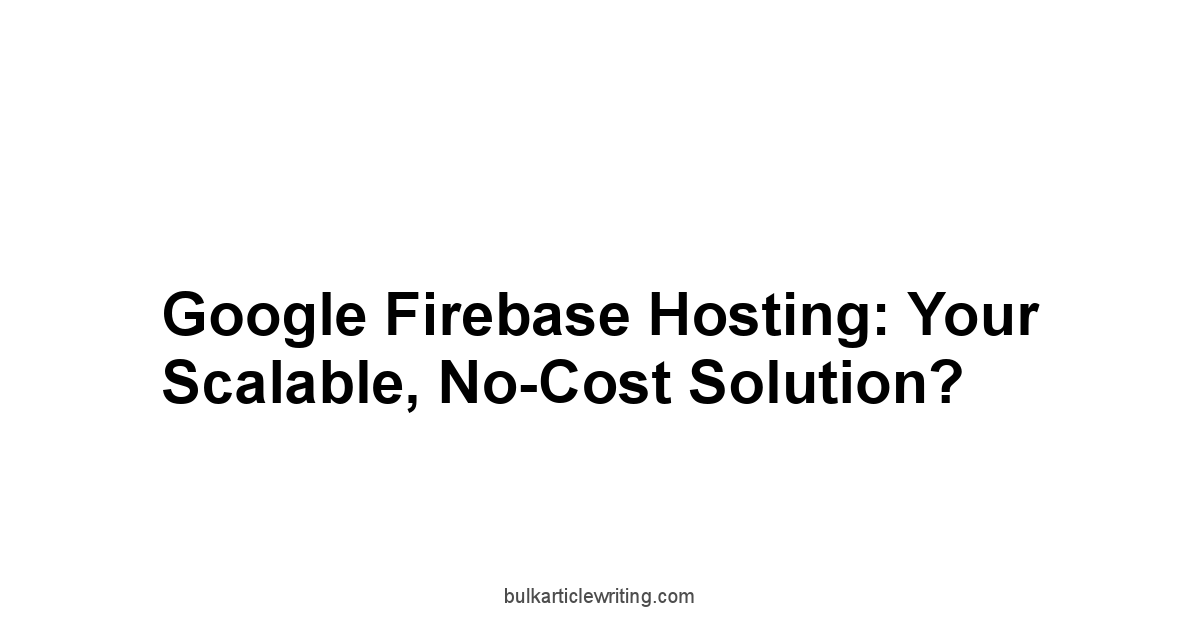
Firebase Hosting, offered by Google, is a popular choice for deploying web applications and static websites.
While it does offer a free tier, it’s crucial to understand its limitations to avoid disappointment down the line.
Firebase is known for its scalability, but that scalability isn’t entirely free. Best Html Editor Free
Diving Deep: Understanding Firebase’s Free Tier
Firebase’s free tier is surprisingly generous, especially for getting started.
You get a certain amount of storage, bandwidth, and hosting capabilities without paying anything.
This makes it ideal for testing apps, personal projects, or MVPs.
The generous allowance of free resources is a significant advantage compared to other providers that might cap you immediately.
This means you can potentially host a website for a significant amount of time without any financial burden, especially if your website doesn’t have a high traffic volume. Phonak Paradise Comparison Chart
However, it’s vital to monitor your usage closely.
Exceeding the limits will trigger charges, which can quickly escalate if you’re not careful.
The free tier is designed for small-scale projects.
if your application or website grows in popularity, the costs can easily outstrip the initial savings.
Consider the fact that most users will likely hit a limit within a few months. Drawing Tool Online
That’s when the seemingly free service transforms into a significant expense.
Remember that this is typical for these sorts of services, and the free tier is a way to entice you into their system.
- Firebase Free Tier Benefits:
- Ample storage and bandwidth for most small websites.
- Easy integration with other Firebase services.
- User-friendly interface and robust documentation.
- Scalable architecture capable of handling traffic spikes.
- Ideal for testing and deploying MVPs.
Setting Up Shop: A Quick-Start Guide to Firebase Hosting
Setting up a website with Firebase Hosting is surprisingly straightforward.
The process usually involves creating a Firebase project, connecting it to your Git repository, and deploying your code.
Firebase offers excellent documentation and tutorials to guide you through every step, making the whole process very accessible for developers of all skill levels. Host Website Free
Firebase’s intuitive command-line interface streamlines this process, which could mean faster setup times than some alternatives.
Many developers find the integration with other Firebase services to be very beneficial.
If you are already using other Firebase services like authentication or database, hosting is very seamless.
This integration could prove useful for developers who already value the wider Firebase ecosystem, increasing efficiency and potentially reducing overall development time.
Think of it as a one-stop-shop for various web development functionalities. Free Pdf Editor Best
However, keep in mind that this integration may also limit your flexibility if you choose to transition to different services in the future.
-
Steps to deploy your website on Firebase:
-
Create a Firebase project in the Firebase console.
-
Initialize Firebase in your project directory.
-
Connect your project to your Git repository. Free Hosting Websites
-
Deploy your website using the Firebase CLI.
-
Monitor your site’s performance using Firebase’s monitoring tools.
-
Real Talk: When Firebase’s Free Plan Starts Showing Cracks
While Firebase’s free tier is generous initially, it does have limitations.
The free tier’s bandwidth and storage capacities are not limitless.
Once you surpass those limits, expect costs to quickly increase. Edit Pdf Free
The free tier is suitable for small projects or those in the testing phase, but for high-traffic websites or complex applications, it might not be sustainable in the long run.
You’ll need to upgrade to a paid plan to scale your website.
This also becomes relevant if you’re planning on using many other Firebase services – these can accumulate costs too.
Another often-overlooked point is the reliance on Google’s ecosystem.
While the integration is a positive point for many developers, it can also present a challenge if you decide to move your projects to other hosting providers in the future. Wat Is Een Juiste Zoekwoorddichtheid
Switching to a different platform could require significant rework, which isn’t always feasible.
This factor must be considered when choosing a hosting provider, especially for larger, more complex projects, which could be costly and time-consuming to transfer.
Ultimately, Firebase offers a compelling free plan for smaller projects but requires careful monitoring of resource usage and a realistic assessment of scalability needs.
Netlify and Vercel offer similar free tiers, worth comparing.
Netlify: Blazing-Fast Static Sites Without Breaking the Bank
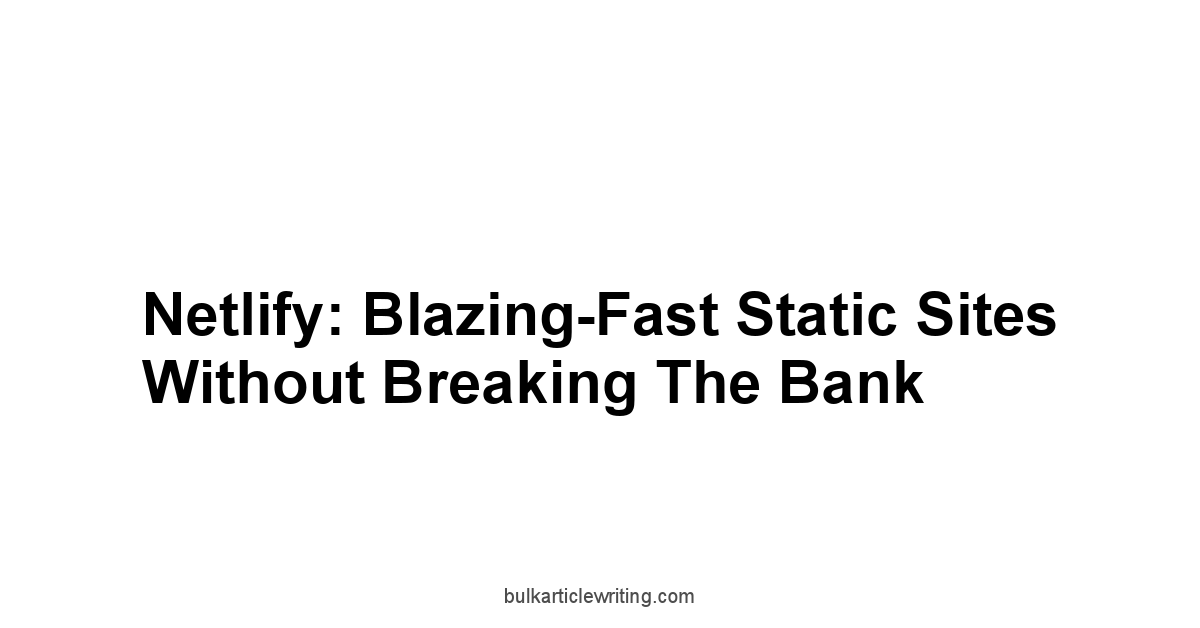
Netlify has become a popular choice for deploying static websites, known for its speed, simplicity, and generous free plan.
It leverages a global content delivery network CDN to ensure fast loading times for your visitors worldwide.
Netlify’s Edge: Speed, Simplicity, and a Generous Free Plan
Netlify’s primary advantage is its speed.
Its CDN ensures quick loading times, regardless of your visitors’ geographic location. Product Analytics Free
This improved performance can be a significant factor in user experience and search engine optimization SEO. The platform also stands out with its simple and intuitive interface, making it easily accessible even for developers with limited experience.
The whole deployment process is usually very smooth, speeding up your workflow.
The generous free plan is another compelling reason to consider Netlify.
You get a decent amount of bandwidth and storage, sufficient for many small to medium-sized websites.
The free plan often comes with many features commonly found in paid hosting plans, like automated builds, continuous deployment, and form handling.
This reduces the need to invest in costly third-party tools, thus minimizing your financial burden. But, as with all things free, there are limits.
- Key features of Netlify’s free plan:
- Global CDN: Fast loading times for users worldwide.
- Automated builds and deployments: Streamlines the deployment process.
- Form handling: Built-in functionality for handling website forms.
- Custom domains: Ability to use your own domain name.
- Free SSL certificates: Secure your website with HTTPS.
Deploying in Minutes: Getting Your Site Live with Netlify
Netlify’s deployment process is incredibly streamlined.
You can connect your Git repository like GitHub, GitLab, or Bitbucket, and Netlify will automatically build and deploy your website whenever you push changes.
This automation simplifies the process and saves you time and effort.
This process is so efficient that deploying your site is potentially faster compared to other providers.
This ease of use is particularly beneficial for developers who are already comfortable with Git workflow.
Netlify seamlessly integrates with many popular frontend frameworks like React, Vue, and Angular, making the deployment of complex web applications easier.
This seamless integration could significantly speed up your workflow, allowing you to focus on developing your web application rather than getting bogged down in complex setup and deployment processes.
- Deploying a site on Netlify:
- Create a Netlify account.
- Connect your Git repository.
- Configure the build settings.
- Deploy your site.
- Monitor site performance.
The Catch: Resource Limits and Scaling Considerations on Netlify
Despite its generosity, Netlify’s free plan has limitations.
The storage and bandwidth allowances are finite and could prove insufficient for high-traffic websites.
For large-scale projects or websites expecting significant growth, you may need to upgrade to a paid plan.
Also, certain features might be limited or unavailable on the free tier.
Another significant aspect is Netlify’s focus on static sites.
While it can handle serverless functions, Netlify is optimized for static content.
If your website requires server-side rendering or complex server-side logic, you might find it less suitable than other options like Heroku or even Google Firebase Hosting, which offer more comprehensive server-side capabilities.
Therefore, carefully evaluate your website’s requirements before relying solely on Netlify’s free offering.
Vercel: Is It the Ultimate Frontend Developer’s Playground?

Vercel is another popular platform for deploying static websites and web applications, particularly those built with modern JavaScript frameworks like Next.js, React, Vue, and Angular.
It’s known for its speed and seamless integration with these frameworks.
Vercel’s Sweet Spot: Next.js and Modern Web Frameworks
Vercel shines when deploying applications built using Next.js, a popular React framework.
The integration is incredibly smooth, making deployment a breeze.
It understands the nuances of these frameworks, making optimizing for performance easier.
Vercel’s deployment process is generally very fast, and the platform often helps optimize your website’s performance through various strategies, including caching and efficient resource management.
This is a key advantage for developers using these specific frameworks.
- Vercel’s strengths:
- Excellent Next.js support: Seamless integration and optimized performance.
- Fast deployment: Rapid and efficient deployment process.
- Global CDN: High performance and low latency worldwide.
- Serverless functions: Ability to execute server-side code.
- Preview deployments: Preview changes before deploying to production.
Instant Deployment: The Vercel Workflow Explained
Vercel’s deployment process is designed for speed and efficiency.
You connect your Git repository, and Vercel will automatically build and deploy your project when you push new code.
The platform excels in handling the intricacies of modern JavaScript frameworks.
It automatically detects the framework used and uses the optimized build process, often minimizing the build time compared to deploying with other platforms.
This makes the process very smooth for developers who prioritize speed and agility.
- Vercel deployment steps:
- Create a Vercel account.
- Import your project from a Git repository.
- Deploy your project.
- Monitor your project’s performance.
Weighing the Options: When Vercel’s Free Tier Makes Sense
Vercel’s free tier is suitable for smaller projects and personal websites.
It provides ample resources for many projects, especially when using Next.js and other supported frameworks.
However, similar to other free hosting services, it has limitations in terms of bandwidth, storage, and the number of deployments.
High-traffic projects or resource-intensive apps may require a paid plan to function properly.
Also, Vercel is best for projects that are aligned with its ecosystem.
If you’re using different technologies or frameworks, other options might be a better fit.
Choosing between Vercel, Netlify, and Google Firebase Hosting largely depends on your specific needs and project requirements.
Consider factors like the framework you’re using, the expected traffic volume, and the types of features you need.
GitHub Pages: Harnessing the Power of Git for Website Hosting
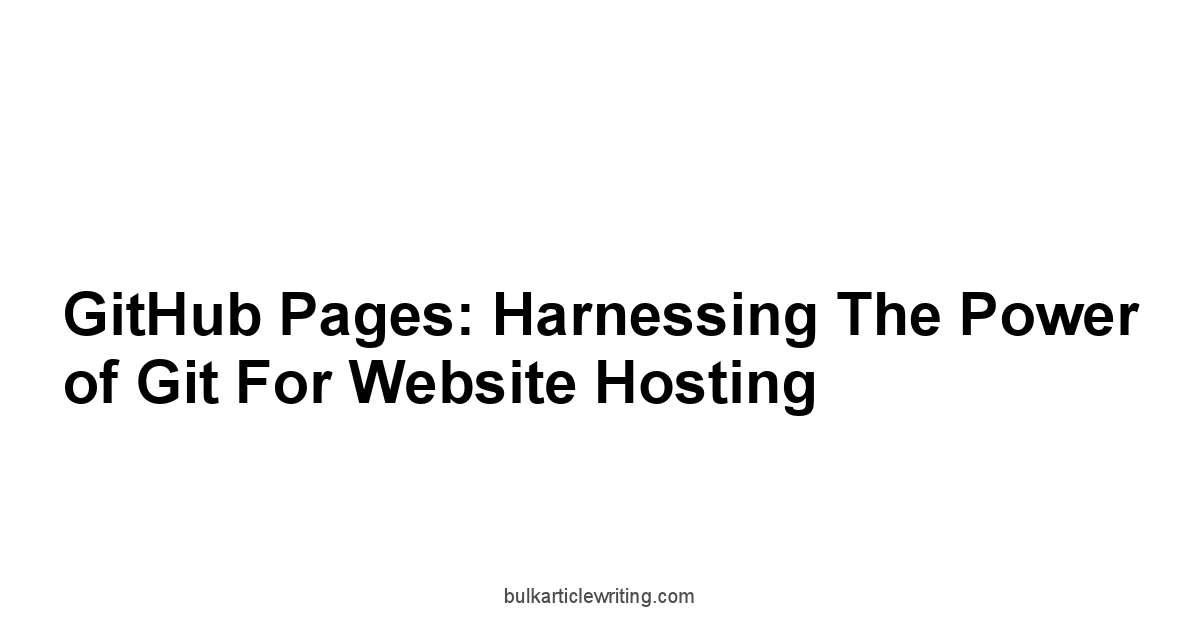
GitHub Pages is a static website hosting service directly integrated into GitHub.
It’s a simple, convenient option for developers who already use GitHub for version control.
The Developer’s Choice: GitHub Pages for Project Portfolios
GitHub Pages is incredibly developer-friendly.
If you’re already using Git and GitHub for your projects, hosting your website on GitHub Pages feels natural.
It’s a seamless extension of your existing workflow, streamlining the process of deploying and updating your website.
This is particularly convenient for developers who want to showcase their projects or build a simple portfolio website.
- Benefits of using GitHub Pages:
- Tight integration with GitHub: Streamlines workflow for developers using Git.
- Simple deployment: Easy to set up and deploy static websites.
- Free and reliable: A cost-effective and dependable hosting solution.
- Version control: Track changes and revert to previous versions easily.
- Collaboration: Easy collaboration with team members on your website.
From Repo to Reality: Publishing Your Site with GitHub Pages
The deployment process for GitHub Pages is straightforward.
You create a repository, add your website’s files, and configure the settings to publish it.
GitHub will then host your website, making it accessible through a unique URL provided by GitHub.
This usually involves creating a specific branch within your repository, and then GitHub automatically handles the deployment process.
GitHub provides clear documentation and instructions for setting up and deploying your website.
The process is quite simple, especially for developers familiar with Git commands.
This simplicity makes it a perfect solution for those who prefer a straightforward approach to web hosting, especially when you need to update your site frequently.
Updates are seamlessly integrated into your Git workflow.
- Publishing a website on GitHub Pages:
-
Create a new GitHub repository.
-
Add your website files to the repository.
-
Configure the settings for GitHub Pages.
-
Push your code to the repository.
-
Your website will be published at a unique URL.
-
The Trade-offs: Static Sites Only and Limited Customization
GitHub Pages has limitations.
It’s designed for static websites, meaning you can’t run server-side code or databases directly on it.
If your website requires dynamic content or complex backend logic, you’ll need a different solution.
The customization options are also relatively limited compared to other hosting services.
You might need to work around certain restrictions regarding the structure or functionality of your website.
The limitations highlight the importance of understanding the type of website you are building.
GitHub Pages is excellent for static websites like portfolios, blogs with static content, or simple documentation websites.
However, for projects that require dynamic content, interactive elements, or extensive server-side processing, GitHub Pages is not the most suitable option.
Always weigh these trade-offs when deciding on whether this is right for your project.
You can always use a separate service for your backend, but that might add complexity.
Consider Netlify or Vercel as alternatives for more dynamic needs.
Cloudflare Pages: A Contender in the Free Hosting Arena?
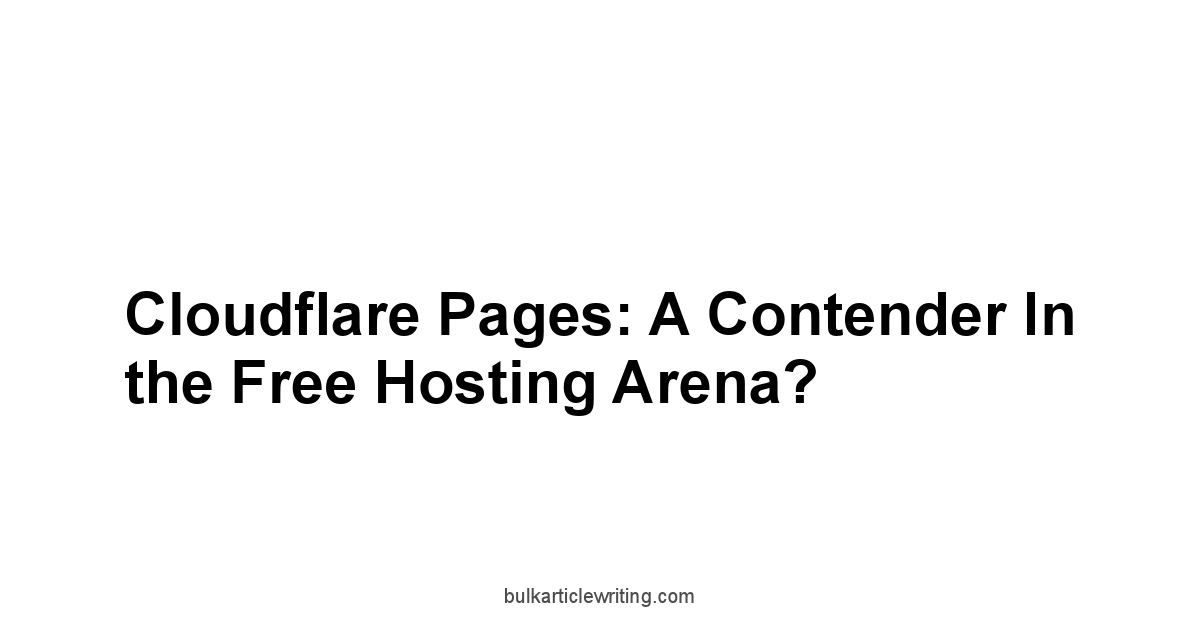
Cloudflare Pages is a relatively newer player in the free hosting arena, but it’s quickly gaining popularity thanks to its integration with the Cloudflare network, known for its speed and security.
Leveraging the Cloudflare Network: Speed and Security on a Budget
One significant advantage of Cloudflare Pages is its use of Cloudflare’s global CDN.
This ensures fast loading times for visitors worldwide, which is crucial for user experience and SEO.
Cloudflare also has a strong reputation for security, so your website benefits from Cloudflare’s protective measures.
This helps mitigate potential threats and protects your website from attacks.
This is a distinct advantage, especially when dealing with free hosting.
- Cloudflare Pages features:
- Global CDN: Fast loading times globally.
- Improved security: Enhanced security through Cloudflare’s network.
- Easy deployment: Simple and straightforward deployment process.
- Integration with other Cloudflare services: Seamless workflow.
- Serverless functions: Ability to run server-side code.
Deploying with Cloudflare Pages: A Seamless Integration
Deploying to Cloudflare Pages is very simple.
You can connect your Git repository GitHub, GitLab, Bitbucket, and Cloudflare Pages will automatically build and deploy your website.
The process is straightforward and intuitive, allowing you to get your website online quickly without much technical expertise.
The integration with other Cloudflare services further simplifies the workflow, reducing the need to manage multiple accounts or interfaces.
The platform is designed to support modern JavaScript frameworks like React, Vue, and Angular.
This makes deploying web applications and complex projects very straightforward.
The ease of deployment is another crucial aspect that makes this a suitable option for various projects, especially if you’re already leveraging Cloudflare services or if your project is well-suited to the platform’s capabilities.
- Deploying your site on Cloudflare Pages:
-
Create a Cloudflare account.
-
Configure build settings.
-
Monitor your site’s performance and security.
-
Is Cloudflare Pages Right for You? Evaluating its Strengths and Weaknesses
Cloudflare Pages offers a compelling combination of speed, security, and ease of use.
However, like other free hosting options, it has limitations.
The free plan comes with constraints on resources, limiting its suitability for high-traffic websites or resource-intensive applications.
Also, the platform is relatively newer compared to established players like Netlify or Firebase, so its community support might be smaller.
This relative newness could also translate into occasional quirks or unexpected behaviors.
However, given Cloudflare’s reputation in the industry, it is generally considered reliable and provides sufficient support.
Its strengths in terms of speed, security, and simplicity of deployment make it a noteworthy option, especially for smaller projects or those prioritizing fast loading times and robust security.
Comparing it with Google Firebase Hosting and Netlify should give you a clearer picture of which aligns best with your needs.
InfinityFree: Truly Unlimited? Digging Into the Details

InfinityFree often advertises itself with the promise of “unlimited” resources.
However, this term requires careful scrutiny, as it’s rarely truly unlimited in the free hosting world.
The Promise of Unlimited: Examining InfinityFree’s Bold Claims
The term “unlimited” is often a marketing ploy, and InfinityFree is no exception.
While they provide generous resource allowances compared to some other free hosting providers, there are still restrictions.
These limitations typically involve fair-use policies that can be triggered by excessive resource consumption.
For instance, using significantly more storage or bandwidth than the average user can result in account suspension or a requirement to upgrade to a paid plan.
While they don’t explicitly state hard limits, exceeding the implicit limits can cause issues.
- InfinityFree’s “unlimited” resources: Often subject to fair-use policies. Exceeding those limits could result in service disruptions.
Signing Up and Setting Up: Navigating the InfinityFree Interface
Signing up for InfinityFree is fairly straightforward.
The signup process is simple and requires minimal information.
The control panel is user-friendly, although not as sophisticated as some other platforms.
However, for basic website hosting, it offers sufficient tools and functionalities.
The interface is geared towards simplicity, making it easily accessible for beginners.
- Setting up a website on InfinityFree:
-
Create an account.
-
Choose a hosting plan.
-
Configure your domain name.
-
Install your website using the provided tools e.g., one-click WordPress installer.
-
Customize your website as needed.
-
The Reality Check: Ads, Restrictions, and Long-Term Viability
While InfinityFree’s generous resource allocation is attractive, the presence of ads on your website is a major drawback.
This can negatively impact the professionalism and user experience of your website.
There are also restrictions on the types of websites you can host, limiting its applicability to specific projects.
Moreover, the long-term viability of free hosting services is always a concern.
The service could be shut down or drastically changed at any time, potentially leading to data loss or website disruption.
Considering these aspects, InfinityFree might be suitable for simple, low-traffic websites with minimal resource requirements.
However, its limitations regarding ads, restrictions, and long-term stability should be carefully evaluated.
For projects with greater needs or long-term goals, it might be best to invest in a paid hosting solution, which offers better reliability, control, and support.
Remember that free hosting is often not the most reliable long-term solution.
This is particularly relevant when you’re dealing with a provider that relies heavily on “unlimited” claims that might not reflect the real-world usage of their services.
Explore GitHub Pages or a low-cost paid option if you need something more reliable.
Heroku: Free Website Hosting for Server-Side Applications
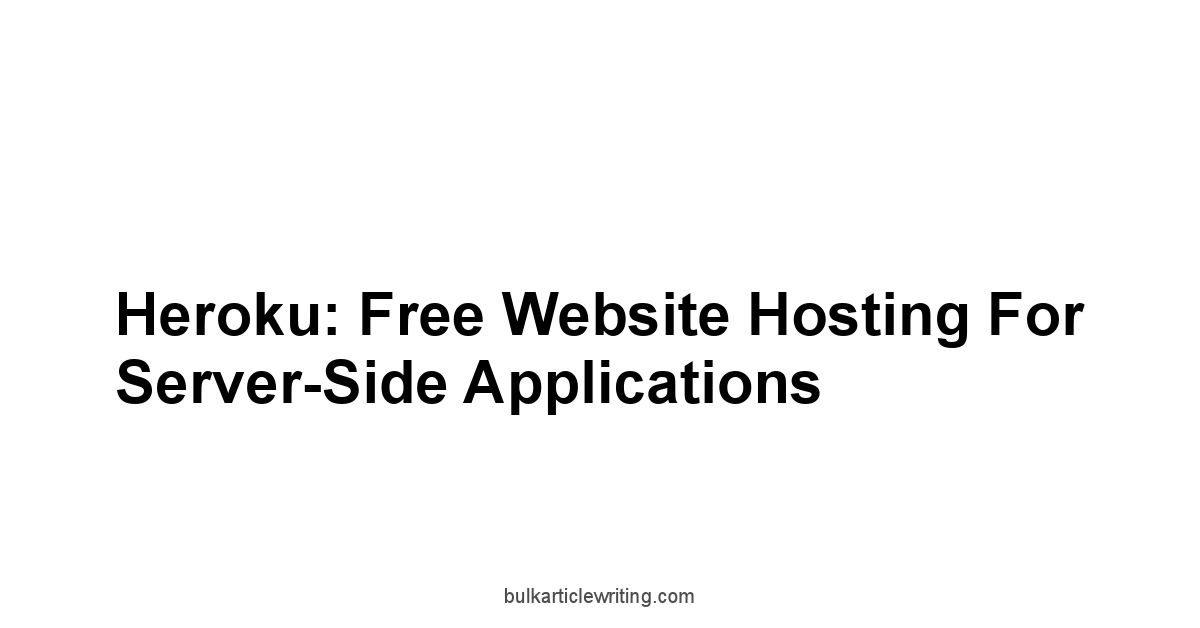
Heroku stands out from the other free hosting options as it primarily caters to server-side applications.
It’s a powerful platform for deploying dynamic websites and web applications, particularly those built using various programming languages and frameworks.
The Power of Heroku: Free Hosting for Dynamic Applications
Heroku’s strength lies in its ability to host dynamic applications.
Unlike the other services discussed, which primarily cater to static websites, Heroku allows you to deploy applications built using various programming languages and frameworks like Node.js, Python, Ruby, Java, and PHP.
This makes it a suitable option for more complex projects requiring server-side processing and database interactions.
This capability is beneficial for individuals or companies working with dynamic content or projects requiring server-side code.
You can build and deploy web applications, APIs, and various other types of server-side solutions using Heroku’s free tier.
The platform’s support for multiple programming languages provides flexibility for developers to choose the best technology for their specific needs, and the deployment process is fairly smooth, allowing you to quickly launch and test your applications without significant technical overhead.
- Heroku’s advantages:
- Support for multiple languages and frameworks: Flexibility in technology choice.
- Scalability: Ability to scale your application as needed.
- Built-in tools: Access to various development and deployment tools.
- Community support: A large community of developers to support you.
- Integration with other services: Seamless integration with other services.
Understanding Heroku’s Free Tier: Limitations and Capabilities
Heroku’s free tier comes with limitations, mainly focused on resource consumption and application uptime.
Your application might experience downtime if it remains idle for a certain period.
This downtime isn’t ideal for applications that need constant uptime.
Also, the free tier has restrictions on the amount of memory, storage, and processing power available for your application.
Exceeding these limits could lead to service interruptions or the necessity to upgrade to a paid plan.
Understanding these limitations is crucial when planning to use Heroku’s free tier.
The free tier is best suited for small-scale projects, prototypes, or applications with low resource consumption.
For high-traffic or resource-intensive applications, upgrading to a paid plan is typically necessary to ensure sufficient performance and avoid disruptions.
Always monitor resource consumption carefully to ensure you are not exceeding the free tier’s limits.
Unlike many static site hosts, Heroku’s free tier is designed for very specific purposes and usage patterns.
- Deploying an app on Heroku:
- Create a Heroku account.
- Create a new Heroku app.
- Connect your Git repository.
- Deploy your app.
- Monitor its performance.
When to Use Heroku: Ideal Use Cases for Heroku’s Free Hosting
Heroku’s free tier is ideal for prototyping, testing, and deploying small-scale server-side applications.
It’s suitable for developers experimenting with new ideas, learning new technologies, or building small-scale applications without substantial resource needs.
However, for applications that require high availability, significant processing power, or large amounts of storage, a paid plan would be more suitable.
It’s important to consider the nature of your project.
If your project relies heavily on server-side processing, databases, or needs to handle considerable traffic, carefully evaluate the Heroku free tier’s limitations.
If your resource needs align with the free tier’s capabilities, Heroku offers a compelling platform to deploy and manage your application.
For applications requiring more resources, the paid options provide the necessary scalability and performance guarantees.
This platform excels in situations where other free hosting providers would fall short because of their static website focus.
Consider Heroku if your project requires server-side logic and you are comfortable with the limitations of the free tier.
Frequently Asked Questions
What is free website hosting, and why is it appealing?
Yes, free website hosting offers website space without upfront costs, making it appealing for beginners, students, and those testing MVPs.
It lowers the barrier to entry significantly, allowing you to get online quickly on platforms like GitHub Pages or InfinityFree. The ease of use is a huge draw too.
What are the common limitations of free website hosting?
Yes, free hosting comes with limitations.
Expect restrictions on storage, bandwidth, features like email accounts or SSL certificates, and performance slower loading times due to shared servers. Many providers will also display ads on your site, impacting its professionalism.
Services like InfinityFree might advertise “unlimited” resources, but that often comes with fine print and fair-use policies. Always check the terms of service!
Is free hosting suitable for all types of websites?
No, free hosting isn’t for every project.
Simple personal blogs or portfolios might work well on GitHub Pages or Netlify. But if you anticipate high traffic, need lots of storage, or require advanced features, a paid plan is almost certainly necessary.
How does Google Firebase Hosting’s free tier work?
Yes, Firebase offers a generous free tier, but it’s not unlimited.
You get storage and bandwidth allowances, ideal for small projects and MVP testing.
However, exceeding limits will trigger charges, which can quickly add up.
It’s a great starting point for small projects but not a long-term solution for high-traffic sites.
How do I deploy a website using Firebase Hosting?
Yes, Firebase Hosting’s deployment is straightforward.
Create a Firebase project, connect it to your Git repository, and deploy your code using the Firebase CLI.
Their documentation provides detailed instructions.
When should I consider upgrading from Firebase’s free tier?
Yes, you need to upgrade if your usage consistently exceeds the free limits.
High-traffic sites or those demanding more storage and bandwidth will quickly outgrow the free tier.
Also consider upgrading if you rely heavily on other Firebase services. those costs can add up fast.
What are the advantages of Netlify’s free plan?
Yes, Netlify is known for speed thanks to its CDN, simplicity, and a generous free plan.
You get automated builds, deployments, form handling, custom domains, and free SSL certificates—features usually found in paid plans.
How easy is it to deploy a website on Netlify?
Yes, deploying on Netlify is incredibly easy.
Connect your Git repository, and Netlify handles the rest.
It’s optimized for speed, especially for static sites.
What are the limitations of Netlify’s free plan?
Yes, Netlify’s free plan has resource limits storage and bandwidth. High-traffic sites or those with large media libraries might need a paid plan. Also, Netlify shines with static sites.
Complex server-side applications might be better suited elsewhere.
What makes Vercel a good choice for frontend developers?
Yes, Vercel is excellent for modern JavaScript frameworks like Next.js, React, Vue, and Angular.
Its integration is exceptionally smooth, offering fast deployment and optimized performance.
How does the deployment process work on Vercel?
Yes, Vercel’s deployment is fast and automated. Connect your Git repository.
It automatically builds and deploys when you push code.
It cleverly detects and optimizes for different frameworks.
When is Vercel’s free tier a viable option?
Yes, Vercel’s free tier works for smaller projects, personal sites, and those using supported frameworks.
However, high-traffic or resource-intensive applications will require a paid plan.
What are the benefits of using GitHub Pages?
Yes, GitHub Pages is excellent if you already use GitHub.
It integrates seamlessly with your Git workflow, making deployment simple.
It’s free, reliable, and perfect for static websites like portfolios or documentation.
How do I publish a website using GitHub Pages?
Yes, publishing is straightforward: create a repository, add files, configure GitHub Pages settings, and push your code. GitHub handles the rest.
What are the main limitations of GitHub Pages?
Yes, GitHub Pages only supports static websites. No server-side code or databases. Customization is also limited.
What are the key advantages of Cloudflare Pages?
Yes, Cloudflare Pages uses the Cloudflare network, offering excellent speed and security.
Deployment is simple, and it integrates well with other Cloudflare services.
How do I deploy a website to Cloudflare Pages?
Yes, deployment is easy: connect your Git repository and let Cloudflare Pages build and deploy. It supports many modern frameworks.
What are the limitations of Cloudflare Pages’ free plan?
Yes, like other free services, Cloudflare Pages has resource limits.
High-traffic or demanding apps will outgrow the free tier.
It’s also relatively newer, so the community might be smaller.
What does InfinityFree’s “unlimited” hosting actually mean?
No, “unlimited” is misleading.
While InfinityFree offers more generous resource allowances than some, it’s subject to fair-use policies.
Exceeding typical usage might lead to restrictions or account suspension.
How easy is it to set up a website on InfinityFree?
Yes, signing up and using the control panel is user-friendly, even for beginners.
They provide one-click installers for popular CMSs like WordPress.
What are the drawbacks of using InfinityFree?
Yes, InfinityFree displays ads on your site, impacting its appearance.
There are also website type restrictions and concerns about the long-term stability of a free service.
What kind of applications can I host on Heroku’s free tier?
Yes, Heroku is great for server-side apps built with languages like Node.js, Python, Ruby, Java, and PHP.
It handles dynamic websites and web apps needing server-side processing and databases.
What are the limitations of Heroku’s free tier?
Yes, Heroku’s free tier has limits on resources memory, storage, processing power and application uptime.
Idle apps will go down, and exceeding limits leads to disruptions.
How do I deploy an application using Heroku?
Yes, deploying to Heroku involves creating an account, app, connecting your Git repository, and pushing your code. It’s relatively straightforward.
When should I choose Heroku’s free tier over other free hosting options?
Yes, choose Heroku if you have a server-side application that needs more than static hosting.
Other options like GitHub Pages are suitable only for static websites.
What are the best free hosting options for static websites?
Yes, GitHub Pages, Netlify, and Cloudflare Pages are great choices for static sites, each with its own strengths and weaknesses.
Consider your needs and preferences when choosing between them.
Which free hosting provider is best for beginners?
Yes, GitHub Pages and Netlify offer user-friendly interfaces and straightforward deployment processes, making them excellent choices for beginners.
What are the best free hosting options for dynamic websites?
Yes, Heroku is a strong contender for dynamic websites and web applications, although its free tier has resource constraints.
For more robust dynamic hosting, you may eventually need a paid plan.
Can I use a custom domain with free hosting services?
Yes, many free hosting services allow you to use a custom domain, though there might be some configuration steps involved.
Check the specific documentation of the provider you’re using to learn how to set up your custom domain.
Are there any security concerns with using free website hosting?
Yes, security can be a concern.
Free hosting providers often share server resources, potentially making your site more vulnerable to attacks.
However, services like Cloudflare Pages leverage Cloudflare’s security infrastructure, improving your site’s protection.
Always consider implementing your own security measures.
How do I choose the right free hosting provider for my project?
Yes, consider your project’s needs: static or dynamic content? Expected traffic? Required features? Compare the providers discussed—GitHub Pages, Netlify, Vercel, Cloudflare Pages, InfinityFree, and Heroku—and their respective limitations before making a decision.


Leave a Reply